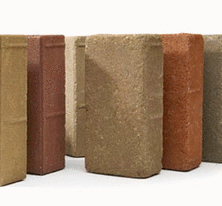
Producing brick from recycled fly ash consumes less energy and emits less CO2 because it does not require firing to harden the masonry units. Nor is any cement, which is also fired at high temperatures, used as a binder. As a result, the CalStar green brick solution represents 85% lower embodied energy and 85% lower CO2 emissions than traditional fired clay brick while maintaining the performance and looks of traditional bricks.
The National Institute of Standards and Technology (NIST) Building for Environmental and Economic Sustainability (BEES) database lists the average embodied energy for a common fired clay brick at 8,800 BTUs. The Brick Industry Association (BIA) notes that a clay brick plant operating at optimal efficiency might reduce this figure to 5,000 BTUs. For purposes of our calculations we have chosen a middle ground of 6,000 BTUs of embodied energy. CO2 emission is often a by-product of energy consumption; each clay brick fired with fossil fuel conservatively released 0.9 lbs of carbon dioxide greenhouse gas into the atmosphere.

Comments by our Users
Be the first to write a comment for this item.